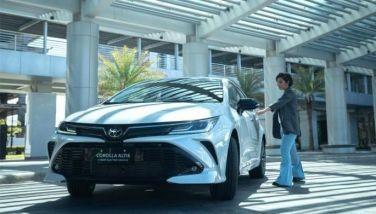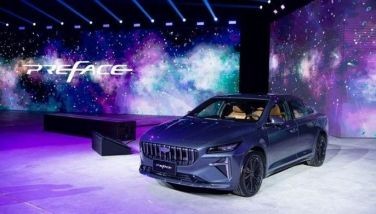10 fuel-efficient cars in a world of high gas prices
It’s Monday, September 19, as I write this. It’s also the day for a major transport strike, with public transportation drivers and operators refusing to ply the streets in protest of high fuel prices.
As an everyday motorist myself, I can’t help feel their pain. High fuel prices have a profound and immediate damaging effect on our budgets and businesses that even the subsequent rise of prices of basic commodities can’t seem to match.
But I also can’t help feel a sense of futility with the transport strike. Fuel prices, after all, are a direct function of world oil prices. (Although the interminable delays in rolling back fuel prices when oil prices go down and the almost instantaneous fuel price hikes when world oil prices go up are both disconcerting and questionable.) Still, the fact remains that, transport strikes aside, gas prices are largely beyond our control.
What to do? Well, we can always stick to steps that are within our control; the more basic of which are eliminating unnecessary trips, being more judicious in planning daily commutes (i.e. avoiding rush hour or areas with traffic jams), keeping our cars well maintained (always in tune, no unnecessary weight in the trunk, and with ideal tire pressures), and driving sensibly (i.e. avoiding fast starts and maintaining a 60-to-80-kph cruising speed).
Of course, what we drive has perhaps the biggest impact on our gas bills. And it is in this light where I make this list. It’s not a ranking nor is it a list of the ten most fuel-efficient cars on the market. If it was, then this list would be populated by 1.0-liter micro-hatchbacks with precious few safety and comfort/convenience features and barely enough room for four.
Here then is a random list of ten fuel-efficient cars, vans, SUVs and pickups trucks that can meet just about every need a typical car/truck owner will have.
Toyota Vios – Toyota’s best-selling subcompact is a perennial leader in the fuel economy stakes. That it’s fun to drive is just the icing on the cake. It’s the no-brainer choice for those who want to avoid gas pains.
Also consider: Ford Fiesta sedan, Honda City, Hyundai Accent, Mazda3 sedan – These four subcompact sedans post similarly stellar fuel consumption numbers as the Vios. They may not be as zippy to drive as the Vios but are more refined and are arguably better looking.
Ford Focus TDCi – Any car with a common-rail direct-injection (CRDi) diesel engine will let you have your cake and eat it, too. Phenomenal torque and fuel economy go hand in hand with this state-of-the-art engine technology. The Focus TDCi, which used to come only in a five-door hatchback body style, is also now available in four-door sedan guise.
Also consider: Chevrolet Cruze CRDi – Few people know it, but Chevy’s handsome and hot-selling Cruze is also available with a CRDi motor. It’s a must-buy – if only its SRP was a good hundred grand lower.
Toyota Innova – Toyota’s other best-seller is the ideal combination of upscale minivan good looks, generous people-carrying capacity, reasonable price, and superb fuel economy – especially when fitted with a CRDi engine and a five-speed stick.
Also consider: Isuzu Crosswind and Mitsubishi Adventure – The Crosswind and the Adventure are nowhere near the Innova in terms of refinement, build quality, performance, and styling. But their diesel engines – albeit of the older-generation non-CRDi type – enable them to deliver fuel economy that’s perfect for a world of high gas prices. They can also seat as many as 10 passengers; something the Innova is hard-pressed to do.
Honda Jazz – Honda’s evergreen hot hatch is the darling of aftermarket tuners and college coeds alike. And for good reason: stylish sheetmetal, lots of space, peppy performance and excellent fuel economy.
Also consider: Ford Fiesta, Mazda3, Suzuki Swift, Toyota Yaris – These four cars belong in the same category as the Jazz. Unlike the Jazz, however, they don’t offer a fuel-sipping combination of a 1.3-liter engine mated to a manual gearbox.
Kia Picanto – Kia’s fresh update on its micro-hatch does wonders for its desirability and cache. Gone is the low-budget feel, replaced now by a boutique look that evokes “poor man’s Mini Cooper” more than “econo-hatch.”
Also consider: Chevrolet Spark, Hyundai i10, Suzuki Alto – Like the new Picanto, the Spark and i10 are positioned as upscale micro-hatchbacks. The Alto foregoes any upmarket aspirations in favor of honest bare-bones economy (in terms of retail price, features, and fuel consumption).
Toyota Prius – Any automobile that can travel over 700 kilometers on one thankful – without resorting to ridiculously slow driving – deserves a spot on a list of fuel-efficient cars. That the Prius can pull off its phenomenal fuel economy figures regardless of driving style and driving conditions is a testament to Toyota’s perfection of hybrid technology. As is the case in many markets, the Philippine government should start offering incentives for manufacturers of hybrids and other alternative powerplants to bring in those cars here.
Also consider: Lexus CT 200h and RX 350h – As the “h” in their model names implies, these two Lexus models are powered by hybrid powerplants. The CT200h is a sport hatch that’s about the same size as a BMW 1-series. The RX350 is Lexus’ best-selling model worldwide and the addition of a hybrid makes it even better in every aspect.
Nissan Navara – Nissan ruggedly handsome truck is a champion in both torque output and fuel economy.
Also consider: Ford Ranger, Isuzu D-MAX, Mazda BT50, Mitsubishi Strada, Toyota Hilux – With each boasting CRDi power, the pickup truck segment is virtually a wash in terms of fuel economy. Pricing and styling are pretty much the biggest differentiators here. The Strada GTV’s variable geometry turbo’s class-leading torque is a compelling attraction, though.
Isuzu Alterra – Need a three-row-seating SUV but don’t want to pay the penalty at the gas pumps? Isuzu’s got the answer for you. Fully loaded with people and cargo, the CRDi-powered Alterra can still deliver close to 20 kpl on a long-distance cruise.
Also consider: Ford Everest, Mitsubishi Montero Sport, Toyota Fortuner – The Montero Sport and the diesel-powered Fortuner offer fuel economy attributes similar to the Alterra’s. Seven- or eight-seat SUV? You won’t go wrong with any of these three.
Hyundai Tucson – Since the Suzuki Vitaras and Kia Sportages of the mid-90s to the first-generation Toyota RAV 4 and Honda CR-V of the mid- to late 90s, Filipinos have always had a soft spot for compact SUVs. Today, if you want a small sport-ute and save fuel at the same time, you go diesel. And here, the Tucson CRDi reigns supreme.
Also consider: Chevrolet Captiva and Kia Sportage – These two Korean-made SUVs share much of the Hyundai’s positive attributes: easy and fun to drive, terrific visibility, impressive versatility. The Captiva has an added advantage of having a seven-seater version. Just make sure to check the box marked “diesel engine,” as all three SUVs have gasoline-powered variants as well.
Any diesel-powered BMW, Mercedes-Benz, Volvo – Just because one can afford a car that’s more expensive than a 3-bedroom townhouse doesn’t mean one won’t care to save frequent trips to the gas station. I’ve driven CRDi-powered Bimmers, Benzes and Volvos – sedans and SUVs – and they’ve all demonstrated superhuman levels of torque-boosted acceleration and fuel economy (approaching a stunning 20 kpl on cruise mode). Nice way to thumb your noses at the oil companies.
- Latest






























